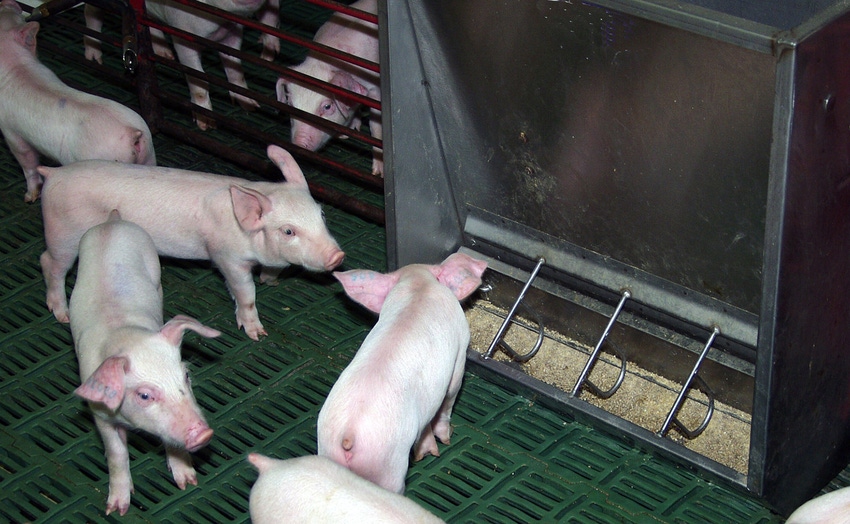What impact does a stimbiotic have on digestibility when fed to weanling pigs?
Opportunity for using more fibrous ingredients, such as cereal grain co-products, if diets are fortified with xylanase or stimbiotic.
May 30, 2024

By Jessica P. Acosta and Hans H. Stein, University of Illinois
Arabinoxylan is the most common fiber component in cereal grains and cereal grain co-products and they have a backbone of β-(1− 4) linked xylose units with side chains of arabinose, glucuronic acid, acetyl and phenolic acids that are difficult to digest for microbial enzymes in the hindgut. Exogenous xylanase may increase the degradation of arabinoxylans resulting in release of xylo-oligosaccharides that can be fermented by pigs. Xylo-oligosaccharides may improve growth performance of weanling pigs because they serve as prebiotics that modulate gut microbiota.
A stimbiotic (i.e., xylanase in combination with xylo-oligosaccharides) may improve growth performance of weanling pigs to a greater extent than either additive alone by shifting the intestinal microbiome to favor fiber fermentation. However, there are no data on the impact of a stimbiotic on digestibility of nutrients when fed to weanling pigs. Therefore, an experiment was conducted to test the hypothesis that xylanase or a stimbiotic improves growth performance and the apparent total tract digestibility of dry matter, gross energy and total dietary fiber, and the concentration of digestible energy in diets for weanling pigs.
A total of 240 newly weaned pigs were used (initial body weight: 5.81 ± 0.50 kg). Pigs were allotted to one of three dietary treatments (i.e., control, control plus 100 g/t of xylanase, or control plus 100 g/t of stimbiotic). The xylanase (Econase XT) and the stimbiotic (Signis) were procured from AB Vista, Marlborough, UK. Pigs were weaned in four blocks and allotted to 12 pens per block, with five pigs per pen for a total of 16 replicate pens per treatment. Pigs were fed phase 1 diets from d 1 to 14, phase 2 diets from d 15 to 28, and phase 3 diets from d 29 to 42 post-weaning. Average daily gain, average daily feed intake and gain:feed were calculated. Fecal samples were collected at the end of phases 2 and 3.
Results indicated that weaned pigs had greater (P < 0.05) ADG, G:F, apparent total tract digestibility of gross energy and total dietary fiber, and digestible energy in phase 2 if fed the diet with stimbiotic than if fed the xylanase diet or the control diet, but pigs fed the xylanase diet had greater (P < 0.05) ADG, G:F, apparent total tract digestibility of gross energy and total dietary fiber, and digestible energy than pigs fed the control diet (Table 1). In phase 3, pigs fed the diet with xylanase or stimbiotic had greater (P < 0.05) ADG, apparent total tract digestibility of gross energy and total dietary fiber, and digestible energy than pigs fed the control diet.

U of I. Table 1. Growth performance of weanling pigs fed experimental diets, and apparent total tract digestibility (ATTD) of gross energy, insoluble dietary fiber (IDF), soluble dietary fiber (SDF), total dietary fiber (TDF), and concentrations of digestible energy in experimental diets fed to weanling pigs1, 2.
Diets rich in dietary fiber generally have lower nutritional value and sometimes this results in reduced growth performance of weanling pigs because pigs lack digestive enzymes to hydrolyze fiber, but incorporating exogenous enzymes and prebiotics in the diet may increase nutrient digestion and absorption, resulting in enhanced growth performance. Indeed, the greater apparent total tract digestibility of total dietary fiber and gross energy and greater digestible energy indicates that xylanase and stimbiotic may enhance the fermentation of arabinoxylans, by releasing xylo-oligosaccharides that are more fermentable and soluble.
Xylo-oligosaccharides are sugar oligomers that are composed of 2 to 10 monomeric units, which may be produced by chemical or enzymatic processing of lignocellulosic materials and subsequently used as a prebiotic in the diet for pigs; however, xylo-oligosaccharides may also be produced in the intestine as a result of the action of dietary exogenous xylanase. Xylo-oligosaccharides may change the composition of the substrate that hindgut microbiota can access, resulting in a prebiotic effect that promotes the proliferation of commensal microbiota and subsequently increase production of short-chain fatty acids, as well as reducing pathogenic bacteria.
Therefore, xylanase or stimbiotic was included in the diets resulted in an improvement in growth performance. This effect is likely due to increased hydrolysis of insoluble dietary fiber. It is possible that the combination of the mechanisms of action of xylanase and xylo-oligosaccharides increased the efficiency of fermenting dietary fiber as indicated by the greater effect of adding stimbiotic than xylanase to the phase-2 diets.
In conclusion, pigs fed diets containing xylanase or stimbiotic had greater energy and nutrient digestibility and greater digestible energy resulting in greater overall ADG, G:F and final body weight on d 42 post-weaning. These results indicate that there is an opportunity for using more fibrous ingredients, such as cereal grain co-products in diets for weanling pigs, if diets are fortified with xylanase or stimbiotic.
You May Also Like



